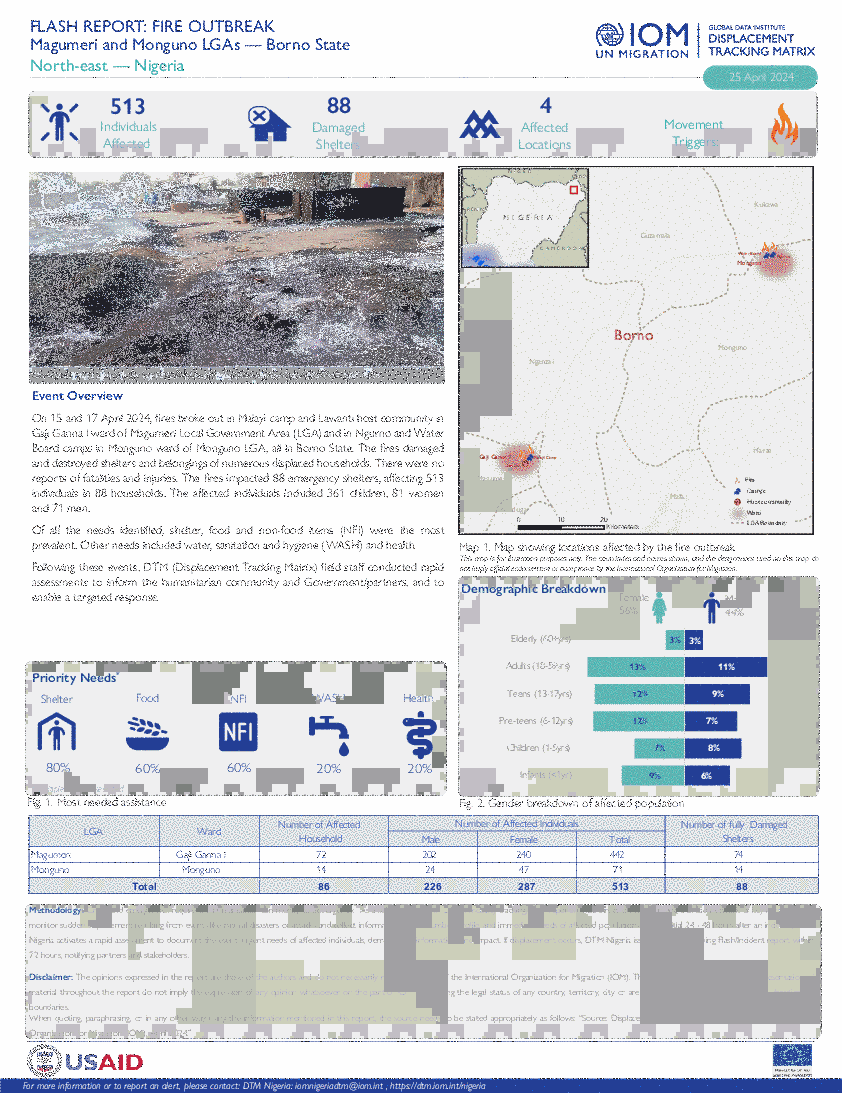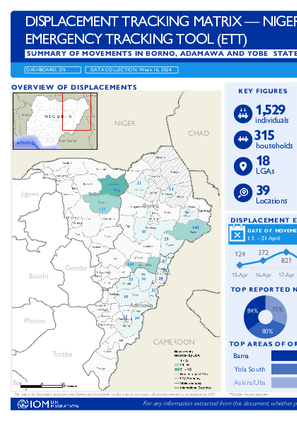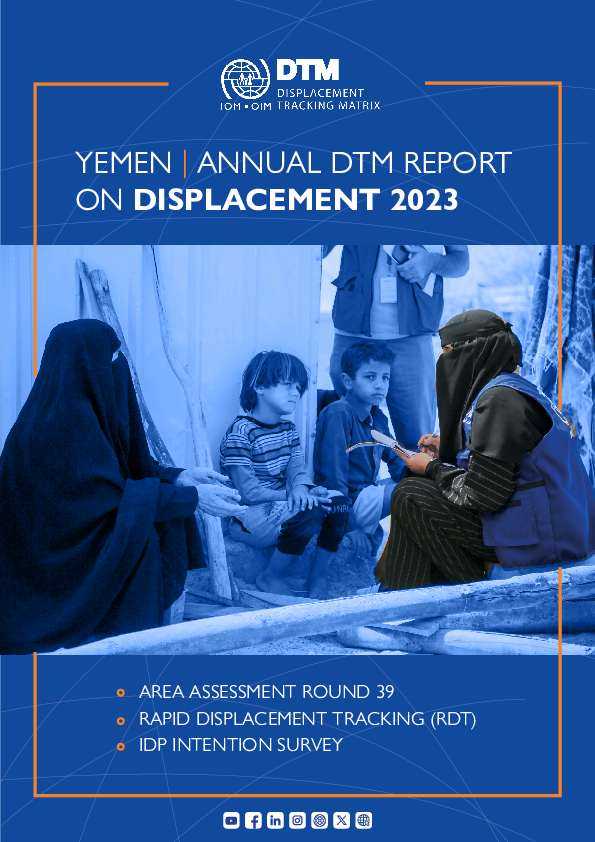-
Countries
-
Data and Analysis
-
Special Focus
-
Crisis Responses
Event Tracking

Contact
DTMMozambique@iom.int
Language
English
Location
Mozambique
Period Covered
Apr 17 2024
Apr 28 2024
Activity
- Mobility Tracking
- Event Tracking
Between 17 to 28 April 2024, sporadic attacks, and fear of attacks by Non-state Armed Groups in Ancuabe and Chiúre triggered the cumulative displacement of 35,948 individuals/8,427 families. The current Movement Alert #107 reports on most recent attacks in southern Cabo Delgado. For more information on displacements between February and March, please see {Emergency Tracking Online Dashboard}.

Contact
dtmmozambique@iom.int
Language
English
Location
Mozambique
Period Covered
Apr 17 2024
Apr 26 2024
Activity
- Mobility Tracking
- Event Tracking
Between 17 to 26 April 2024, sporadic attacks, and fear of attacks by Non-state Armed Groups in Ancuabe and Chiúre triggered the cumulative displacement of 19,208 individuals/4,448 families. The current Movement Alert #106 reports on most recent attacks in southern Cabo Delgado. For more information on displacements between February and March, please see {Emergency Tracking Online Dashboard}.
Contact
DTM Yemen, iomyemendtm@iom.int
Location
Yemen
Activity
- Mobility Tracking
- Event Tracking
Period Covered
Apr 21 2024 -Apr 27 2024
From 1 January to 27 April 2024, IOM Yemen DTM tracked 1,067 households (HH) (6,402 Individuals) who experienced displacement at least once.
Between 21 and 27 April 2024, IOM Yemen DTM tracked 39 households (234 individuals) displaced at least once. The majority of people moved into/within the following governorates and districts:
- Ma’rib (34 HHs) – Ma’rib (21 HH), Ma’rib City (11 HH), Harib (2 HHs) districts. Most displacements in the governorate originated from Ma’rib and Al Hodeidah.
- Ta’iz (5 HHs) – Jabal Habashi (4 HHs), As Silw (1 HH) districts. Most displacements in the governorate were internal.
The majority of people moved from the following governorates and districts:
- Ma’rib (8 HHs) – Al Jubah (2 HHs), Majzar (2 HHs), Bidbadah (1 HH) districts.
- Ta’iz (7 HH) – Maqbanah (4 HHs), Al Misrakh (1 HH), Al Qahirah (1 HH) districts.
- Al Hodeidah (5 HH) – Bayt Al Faqih (1 HH), Al Mansuriyah (1 HH), As Salif (1 HH) districts.
Population Groups
Survey Methodology
Unit of Analysis Or Observation
Type of Survey or Assessment
Keywords
Geographical Scope
Administrative boundaries with available data
The current dataset covers the following administrative boundaries

Contact
dtmhaiti@iom.int
Language
English
Location
Haiti
Period Covered
Apr 25 2024
Apr 26 2024
Activity
- Mobility Tracking
- Event Tracking
This information was gathered following an armed attack that occurred on 25 April 2024, in the commune of Delmas, specifically in the neighborhood of Cité Numéro 2. As a result of this incident, individuals who were sheltered in three sites located in the neighborhood of Cité Numéro 2 and Carrefour Pean completely evacuated these sites, leading to the displacement of internally displaced persons (IDPs). In total, 1,629 individuals were displaced from these three sites, along with residents from the Cité Numéro 2 neighborhood. The IDPs headed towards the communes of Port-au-Prince and Delmas. Among them, 29% found refuge with host families, while 71% settled in four sites, including two newly established sites and two existing sites. Updates will be provided as the destinations of other individuals are identified.

Contact
DTM Nigeria, AllUsersInDTMNigeria@iom.int
Language
English
Location
Nigeria
Period Covered
Apr 15 2024
Apr 17 2024
Activity
- Mobility Tracking
- Event Tracking
On 15 and 17 April 2024, fires broke out in Malayi camp and Lawanti host community in Gaji Ganna I ward of Magumeri Local Government Area (LGA) and in Ngurno and Water Board camps in Monguno ward of Monguno LGA, all in Borno State. The fires damaged and destroyed shelters and belongings of numerous displaced households. There were no reports of fatalities and injuries. The fires impacted 88 emergency shelters, affecting 513 individuals in 88 households. The affected individuals included 361 children, 81 women and 71 men.
Of all the needs identified, shelter, food and non-food items (NFI) were the most prevalent. Other needs included water, sanitation and hygiene (WASH) and health.

Contact
DTM Nigeria, iomnigeriadtm@iom.int
Language
English
Location
Nigeria
Period Covered
Apr 15 2024
Apr 21 2024
Activity
- Mobility Tracking
- Event Tracking
Between 15 and 21 April 2024, a total of 1,529 new arrivals were recorded at locations in Adamawa, Borno and Yobe states. The new arrivals were recorded at locations in Askira/Uba, Bama, Dikwa, Gubio, Gwoza, Konduga and Monguno Local Government Areas (LGAs) of the most conflict-affected Borno State, in Fufore, Gombi, Hong, Madagali, Maiha, Michika, Mubi North, Song and Yola North LGAs of Adamawa State and in Geidam and Tarmuwa LGAs of Yobe State.
ETT assessments identified the following movement triggers: fear of attack (500 individuals or 33%), poor living conditions (409 individuals or 27%), family re-unification (238 individuals or 15%), improved security (163 individuals or 11%), seasonal farming (113 individuals or 7%) and military operations (106 individuals or 7%).

Contact
DTM Yemen, IOMYemenDTM@iom.int
Language
English
Location
Yemen
Period Covered
Jan 01 2023
Dec 31 2023
Activity
- Survey
- Mobility Tracking
- Event Tracking
- Baseline Assessment
Please note that this report is divided into three sections:
- Area Assessment (AA)
- Rapid Displacement Tracking (RDT)
- The IDP Intention Survey (IS)
The report contains cross-cutting descriptive analyses from a combination of data sources to provide the best possible overview.
The Area Assessment remains the most suitable source of information on target population sizes and locations. Rapid Displacement Tracking (RDT) should be understood as indicative of new displacement events and trends without serving as a source of population sizes as households may experience multiple displacements during the reporting period or might have returned before the end of the reporting period. Both the Area Assessment and RDT are based on key informant interviews. The intention survey (here based on 13,307 face-to-face interviews in May 2023) serves to provide insights into past and present motives of displaced populations, thereby providing a more personal profile of affected populations.

Contact
dtmmozambique@iom.int
Language
English
Location
Mozambique
Period Covered
Apr 17 2024
Apr 23 2024
Activity
- Mobility Tracking
- Event Tracking
Between 17 to 23 April 2024, sporadic attacks and fear of attacks by Non-state Armed Groups in Ancuabe and Chiúre triggered the cumulative displacement of 2,160 individuals/488 families. The current Movement Alert #105 reports on most recent attacks in southern Cabo Delgado. For more information on displacements between February and March, please see {Emergency Tracking Online Dashboard}.

Contact
DTM DRC — iomdrcdtm@iom.int
Language
French
Location
Democratic Republic of the Congo
Period Covered
Apr 18 2024
Apr 21 2024
Activity
- Mobility Tracking
- Event Tracking
Depuis le 20 mars 2024, une montée des eaux a été constatée au lac Tanganyika, à la marée de Niangara et aux débordements des rivières Mulongwe, Kalimabenge, Kamvimvira et Kabimba dans la ville d’Uvira, communes de Kalundu, Mulongwe et Kavinvira de la zone de santé d’Uvira. Ces inondations ont affecté sept quartiers (Kalundu, Namianda, Kimanga, Rombe 1 & 2, Kasenga, Kanvinvira), entraînant la destruction de biens, notamment des habitations et des terres agricoles avoisinantes. Les résidents touchés ont été contraints de se réfugier dans des zones non touchées situées dans les quartiers de Kavinvira, Kasenga, Kakombe, Rombe 1, Kimanga, Nyamyanda, Kalundu et Kabimba des communes de Kavinvira, Mulongwe et Kalundu à Uvira. Un total de 6 861 Ménages de 34 358 Individus déplacés internes dont 6 530 Ménages de 32x594 individus en familles d’accueils et 331 ménages de 1 764 Personnes dans les centres collectifs. Plus de 2 800 maisons ont été inondées lors de cet événement. Les dégâts se sont étendus à 17 écoles primaires, 20 écoles secondaires, 7 écoles maternelles et 3 universités, ainsi qu’à 9 églises locales. De plus, plus de 800 robinets d’eau potable ne fonctionnent plus correctement. Les inondations ont également touché 5 marchés importants (le Marché de Frontière, le Marché Tumaini Africa, le Marché Kunzira, le marché Zaïrois et le Marché Maendeleo). Les ports de Kalundu et de Kasenga (Port de Gaby) ainsi que la plage Maendeleo ont été submergés par les eaux. Selon les estimations, plus de 120 hectares de terres agricoles ont été inondés.

Contact
DTM Chad, dtmtchad@iom.int
Language
French
Location
Chad
Period Covered
Feb 24 2024
Mar 10 2024
Activity
- Mobility Tracking
- Event Tracking
• Depuis le début des affrontements au Soudan, plus de 700 000 personnes ont traversé la frontière vers le Tchad. L’OIM estime que plus de 164 422 parmi eux sont des retournés tchadiens et s’attend à ce que ce nombre passe à 204 000 d’ici fin aout 2024, en raison de la reprise du conflit au Darfour et à la suspension actuelle du corridor humanitaire entre Adré et le Darfour.
• En tant qu'agence principale pour la réponse aux retournés, l'OIM collabore avec un éventail de partenaires opérationnels, notamment le gouvernement du Tchad, le HCR, OCHA, la FLM, PUI, l'UNICEF, MSF, l'UNFPA, LMI, le CICR, l'IRC, ACTED, la Croix-Rouge tchadienne, HELP-Tchad, ATURAD, Concern Worldwide, COOPI, INTERSOS et PAM.
• En coordination avec la CNARR et les organisations humanitaires, l'OIM a déjà enregistré plus de 101 347 retournes et 365 ressortissants de pays tiers (Soudan du Sud, Niger, Éthiopie, République centrafricaine, Burkina Faso, Sierra Leone, Nigéria et Ouganda) dans 38 localités de trois provinces.
• La plupart des retournés sont installés spontanément près de la frontière avec le Soudan et ont un besoin urgent de nourriture, d’eau, d’assainissement et d’hygiène, d’abris, d’articles non alimentaires, de soutien sanitaire et de protection.
• L’OIM soutient la relocalisation des retournés d’Adre vers la communauté de retournés nouvellement développée de Tongori, dans la province du Ouaddaï, où elle leur offre des abris, une assistance WASH, NFI et une assistance en matière de protection/MHPSS. Plus de 13 000 personnes ont jusqu’à présent été relocalisées. L'OIM développe également le site de Deguessa, dans la province de Sila, avec une assistance en matière d'abris, de WASH et de protection/MHPSS au profit de plus de 25 000 retournés.
• L'OIM se coordonne avec les autorités locales et les représentations diplomatiques pour le retour volontaire dans leur pays d'origine des ressortissants de pays comme l'Éthiopie, le Soudan du Sud, le Nigéria, le Niger et le Cameroun, vivant auparavant au Soudan et déplacés vers l'est du Tchad.
Pagination
- Previous page
- Page 33
- Next page
